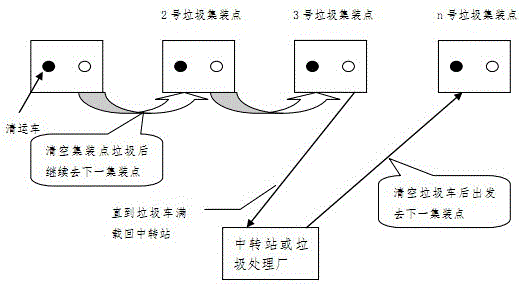Circular and optimized planning method and system for garbage collection and transportation
A technology for garbage collection and cycle optimization, used in instrumentation, data processing applications, forecasting, etc.
- Summary
- Abstract
- Description
- Claims
- Application Information
AI Technical Summary
Problems solved by technology
Method used
Image
Examples
Embodiment
[0048] A cycle-optimized garbage collection and transportation planning method, according to the garbage points that need to be cleared and the amount of garbage generated in a region, using the principle of cost optimization to calculate the type and quantity of garbage removal vehicles required to complete the garbage removal task, Plan the specifications, quantity and location of the transfer stations that need to be built, calculate the number of transfer vehicles required, and arrange the daily route planning of each garbage removal vehicle and transfer vehicle. The embodiment can solve the problem of waste removal and transfer planning in the region within the optimal cost range, and calculate the overall operating cost. The invention belongs to the technical field of computer software and artificial intelligence, and uses a neural network and an adaptive vibration feedback mechanism to solve the combined explosion problem in planning algorithms.
[0049] The first step ...
PUM
 Login to View More
Login to View More Abstract
Description
Claims
Application Information
 Login to View More
Login to View More - R&D
- Intellectual Property
- Life Sciences
- Materials
- Tech Scout
- Unparalleled Data Quality
- Higher Quality Content
- 60% Fewer Hallucinations
Browse by: Latest US Patents, China's latest patents, Technical Efficacy Thesaurus, Application Domain, Technology Topic, Popular Technical Reports.
© 2025 PatSnap. All rights reserved.Legal|Privacy policy|Modern Slavery Act Transparency Statement|Sitemap|About US| Contact US: help@patsnap.com

